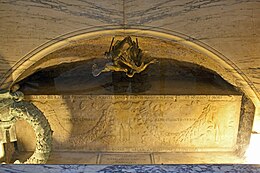20:00 【公視藝文特區】 拉斐爾:天才的光芒
https://en.wikipedia.org/wiki/Raphael
Raphael (1483-1520), Giulio Romano, and others
(1518-1519)
The small two-story Villa Farnesina on the banks of the Tiber was built in 1509 for the Sienese papal banker, Agostino Chigi, as a residence for his mistress. After Chigi, the villa was purchased by the Farnese family (thus the name) and connected by a bridge across the Tiber to the huge Palazzo Farnese on the opposite bank. The garden loggia (1518-19) has frescoes painted by Raphael and his assistants. Painted bands of foliage line each of the groins in the vaulting. Two frescoes on the ceiling depict incidents in the story of Cupid and Psyche which took place in heaven. Scholars suggest that the story cycle alludes to Chigi's own life, and his recent marriage, and thus represents an epithelamion.
Vasari's Life of Raphael calls the painter "a very amorous person," and says, when he was asked to paint the loggia, Raphael
was not able to give much attention to his work, on account of the love that he had for his mistress; at which Agostino fell into such despair, that he so contrivted by means of others, by himself, and in other ways, as to bring it about, although not only with difficulty, that this lady should come to live continually with Raphael in that part of the house wherehe was working; and in this manner the work was brought to completion.
However, As Bellori noted in 1695, the cycle is incomplete. According to most scholars, the work was interrupted when new scaffolding had to be built for the walls. It may be that Raphael's many commitments prevented the work from being completed perhaps because of Raphael's death in 1520.
***
https://en.wikipedia.org/wiki/Sistine_Madonna

Sistine Madonna (1512)
Raphael was highly admired by his contemporaries, although his influence on artistic style in his own century was less than that of Michelangelo. Mannerism, beginning at the time of his death, and later the Baroque, took art "in a direction totally opposed" to Raphael's qualities;[94] "with Raphael's death, classic art – the High Renaissance – subsided", as Walter Friedländer put it.[95] He was soon seen as the ideal model by those disliking the excesses of Mannerism:
the opinion ...was generally held in the middle of the sixteenth century that Raphael was the ideal balanced painter, universal in his talent, satisfying all the absolute standards, and obeying all the rules which were supposed to govern the arts, whereas Michelangelo was the eccentric genius, more brilliant than any other artists in his particular field, the drawing of the male nude, but unbalanced and lacking in certain qualities, such as grace and restraint, essential to the great artist. Those, like Dolce and Aretino, who held this view were usually the survivors of Renaissance Humanism, unable to follow Michelangelo as he moved on into Mannerism.[96]
Vasari himself, despite his hero remaining Michelangelo, came to see his influence as harmful in some ways, and added passages to the second edition of the Lives expressing similar views.[97]

Raphael and Maria Bibbiena's tomb in the Pantheon. The Madonna is by Lorenzetto.

Raphael's sarcophagus
Raphael's compositions were always admired and studied, and became the cornerstone of the training of the Academies of art. His period of greatest influence was from the late 17th to late 19th centuries, when his perfect decorum and balance were greatly admired. He was seen as the best model for the history painting, regarded as the highest in the hierarchy of genres. Sir Joshua Reynolds in his Discourses praised his "simple, grave, and majestic dignity" and said he "stands in general foremost of the first [i.e., best] painters", especially for his frescoes (in which he included the "Raphael Cartoons"), whereas "Michael Angelo claims the next attention. He did not possess so many excellences as Raffaelle, but those he had were of the highest kind..." Echoing the sixteenth-century views above, Reynolds goes on to say of Raphael:
The excellency of this extraordinary man lay in the propriety, beauty, and majesty of his characters, his judicious contrivance of his composition, correctness of drawing, purity of taste, and the skilful accommodation of other men's conceptions to his own purpose. Nobody excelled him in that judgment, with which he united to his own observations on nature the energy of Michael Angelo, and the beauty and simplicity of the antique. To the question, therefore, which ought to hold the first rank, Raffaelle or Michael Angelo, it must be answered, that if it is to be given to him who possessed a greater combination of the higher qualities of the art than any other man, there is no doubt but Raffaelle is the first. But if, according to Longinus, the sublime, being the highest excellence that human composition can attain to, abundantly compensates the absence of every other beauty, and atones for all other deficiencies, then Michael Angelo demands the preference.[98]

沒有留言:
張貼留言